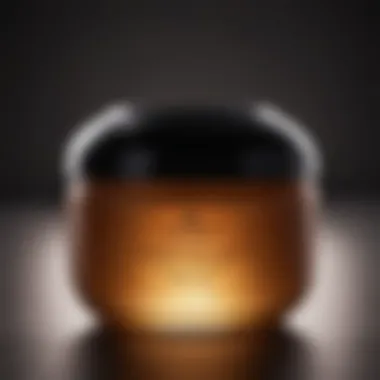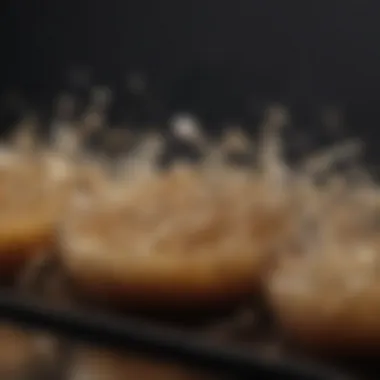Top Conditioners for Revitalizing Color-Treated Hair


Intro
Finding the right conditioner for dry, damaged, color-treated hair can feel daunting. It is essential to address the specific needs of such hair to restore its vitality. Understanding the underlying causes of hair damage is the first step to making informed choices in hair care.
Color-treated hair, while vibrant, often suffers from dryness and brittleness due to the chemical processes involved in dyeing. This results in hair that requires special attention. Conditioners play a crucial role as they help restore moisture, protect hair from further damage, and enhance color retention.
This guide will dissect key trends, suitable products, and application methods that cater to the unique specifications of dry, damaged, color-treated hair. With the right knowledge, individuals can improve both the aesthetic and health of their hair.
Understanding Dry, Damaged, Color-Treated Hair
Understanding the characteristics of dry, damaged, and color-treated hair is crucial in selecting the proper conditioner. Each of these factors contributes significantly to the hair's overall health and appearance. Recognizing these elements allows individuals to make informed choices when it comes to hair care products.
Characteristics of Dry Hair
Dry hair often feels rough or coarse. It may lack elasticity, appearing dull and lifeless. Some common characteristics include:
- Breakage: Dry hair is prone to breakage, making it challenging to grow long, healthy strands.
- Split Ends: Excessive dryness often results in split ends, which can travel up the hair shaft if not addressed.
- Frizz: A lack of moisture leads to frizzy hair, contributing to an unruly appearance.
When hair becomes dry, its protective barrier is compromised, making it susceptible to environmental damage. Therefore, understanding these traits helps pinpoint what type of conditioner might offer the best results to restore moisture and integrity.
Signs of Damage from Color Treatment
Color-treated hair goes through a chemical process that alters its structure, often resulting in damage. Common signs of this damage include:
- Faded Color: Color that appears dull or washed out indicates that the hair is not retaining dye effectively.
- Weakness: The hair may feel weak and brittle, lacking the typical strength of healthy hair.
- Texture Changes: It may also lose its natural texture, leading to an uneven feel.
Recognizing these signs is essential. They serve as indicators that the hair is not only dry but also requires specialized care to address the unique needs of color-treated strands.
The Importance of Proper Care
Proper care for dry, damaged, and color-treated hair is essential to maintaining its health and appearance. Without suitable products, the damage can worsen over time. The benefits of proper care include:
- Restoration of Hydration: The right conditioner can replenish lost moisture, reducing dryness.
- Enhanced Longevity of Color: Using appropriate conditioners can help retain color vibrancy and improve overall shine.
- Reduced Breakage: Good conditioning practices often reduce hair breakage, allowing for healthier growth over time.
Ignoring proper hair care can lead to long-term problems, making it more challenging to restore the hair’s natural beauty. Therefore, understanding the specific needs of dry, damaged, and color-treated hair is the first step towards effective hair management.
The Role of Conditioners in Hair Care
Conditioners are a crucial element in the hair care routine, especially for those with dry, damaged, or color-treated hair. They play a significant role in maintaining hair health, enhancing appearance, and providing essential moisture. Understanding their function can help individuals achieve better results in their hair care regimen. Conditioners not only assist in detangling hair but also form a protective barrier, sealing moisture in and preventing further damage. This section highlights the essential aspects of conditioners and their vital benefits.
How Conditioners Work
Conditioners work by providing a combination of moisturizing and repairing properties. When applied to hair, they adhere to the hair shaft. This helps to smooth the cuticle, which is the outer layer of the hair. The smoothness reduces friction and increases manageability, making it easier to comb through and style the hair. The ingredients in conditioners often help to hydrate dry hair and restore its luster. The increase in moisture can lead to improved elasticity, thereby reducing breakage.
Types of Conditioners Available
Conditioners come in various types, each designed to cater to specific hair needs. Understanding these types is essential for selecting the right product.
Rinse-out Conditioners
Rinse-out conditioners are generally used immediately after shampooing. They are designed to be applied to wet hair for a short duration before being rinsed out. The key characteristic of rinse-out conditioners is their lightweight formulation, making them ideal for daily use. They provide immediate hydration and help detangle hair efficiently. Their unique feature includes a blend of silicones and emulsifiers that coat the hair, offering protection and softness. While they are effective for quick moisture and ease of use, they may not provide the intense nourishment that some damaged hair types require.
Leave-in Conditioners


Leave-in conditioners are applied to hair after washing but left in without rinsing. This type of conditioner is particularly beneficial for dry, color-treated hair, as it provides extended moisture and protection throughout the day. The primary characteristic is their thicker consistency, often enriched with additional oils and hydrating agents. Their unique feature lies in their ability to offer long-lasting benefits, such as reducing frizz and enhancing shine, throughout the day. A possible downside is that they may weigh down fine hair if too much product is used, making it essential to apply them judiciously.
Deep Conditioners
Deep conditioners are intensive treatments meant to restore and repair severely damaged hair. They typically require longer application times compared to other conditioners, allowing the nutrients to penetrate deeply into the hair shaft. Their key characteristic is their rich formulation, often enriched with proteins and oils. This makes them a beneficial choice for restoring moisture and strength to weak hair. The unique feature of deep conditioners is their ability to revitalize hair significantly after just a few uses. However, overuse may lead to product buildup, which can cause hair to feel heavy or greasy; hence it is recommended to use them weekly or biweekly.
"Conditioners are not merely an afterthought in your hair care routine, but a necessity for healthy, vibrant hair."
Key Ingredients in Conditioners for Color-Treated Hair
Choosing the right conditioner for dry, damaged, color-treated hair requires attention to the ingredients that can nourish and restore the hair’s natural beauty. This section covers critical aspects of conditioner ingredients that contribute to hair health, particularly for those with color-treated hair. Understanding these elements can significantly impact the effectiveness of the conditioners you choose.
Moisturizing Agents
Moisturizing agents are essential in conditioners formulated for dry hair. These ingredients help to retain moisture and combat dryness. Common moisturizing agents include:
- Glycerin: A humectant that draws moisture from the air into the hair.
- Aloe Vera: Known for its soothing properties, it also provides hydration.
- Shea Butter: It nourishes the hair, making it softer and more manageable.
These components serve to provide a protective layer around each hair strand. This action helps to prevent future damage and promote overall health. In color-treated hair, where the cuticle may be more porous due to the coloring process, these agents play an even larger role.
Proteins and Strengtheners
Color-treated hair often requires additional strength due to potential damage caused by the dyeing process. Proteins can fortify the hair shaft, making it more resilient. Look for:
- Keratin: This protein, naturally found in hair, helps to restore its structural integrity.
- Silk Protein: Adds shine and smoothness, enhancing the hair's feel and appearance.
- Wheat Protein: Known for its ability to penetrate the hair shaft, it improves moisture retention.
Integrating these proteins helps restore elasticity and reduces breakage. For individuals with chemically treated hair, the right balance of protein can mean the difference between healthy tresses and a frizzy mess.
Color Protecting Compounds
To extend the vibrancy of color-treated hair, look for conditioners that include color protecting compounds. These ingredients help to minimize color fading and maintain the hue's depth and brightness. Key compounds include:
- UV Filters: Protect hair from ultraviolet radiation, which can cause colors to dull.
- Antioxidants: Ingredients such as Vitamin E combat free radicals that may damage hair and contribute to color loss.
- pH Balancing Agents: These help to maintain the hair's natural pH level, keeping color intact.
Employing conditioners with these features assists in preserving the investment made in hair color. This support results in a healthier look and feel overall.
"Using conditioners enriched with these ingredients can foster a dramatic improvement in the manageability and appearance of color-treated hair."
Overall, knowing the key ingredients can lead to more informed choices when selecting conditioners. This attention to detail is necessary for those who wish to restore and care for their hair properly.
Evaluating Specific Products
In the quest for restoring dry, damaged, color-treated hair, evaluating specific products becomes essential. The right conditioner can make a significant difference in the health and appearance of your hair. The abundance of options available in the market can be overwhelming. However, understanding certain elements can simplify the selection process.
When evaluating conditioners, you should focus on ingredients, formulation types, and the specific needs of your hair. Many products feature unique blends that claim to offer remarkable benefits. Ingredients like natural oils, vitamins, and proteins can nourish the hair, providing moisture and strength. It's crucial to verify that the product aligns with your hair’s needs, particularly if it has been subjected to harsh color treatments.
Benefits of evaluating conditioners include:
- Targeted Solutions: Selecting a conditioner that addresses specific issues like dryness or damage can aid in recovery.
- Cost-Effectiveness: Investing in quality products may save you money in the long run by reducing damage and the need for frequent salon treatments.
- Enhanced Hair Health: Consistent use of a well-chosen conditioner can lead to noticeable improvements in hair texture and manageability.
Considerations often include the hair type—whether it is fine, thick, straight, or curly—as well as any sensitivities to certain ingredients. An informed choice leads to optimal results, making the evaluation process paramount.
Best Rinse-Out Conditioners


The rinse-out conditioner serves as a staple in hair care routines. These products typically contain moisturizing and detangling agents, making them ideal for daily use. When selecting rinse-out conditioners for damaged, color-treated hair, look for those rich in nourishing ingredients.
Some qualities of an effective rinse-out conditioner include:
- Hydrating Properties: Ingredients like glycerin or aloe vera are essential for moisture retention.
- Damage Repair: Conditioners containing keratin or hydrolyzed silk can help reconstruct damaged strands.
- Color Safety: Formulas designed to protect color from fading can preserve vibrancy for longer.
Top Leave-In Conditioners
Leave-in conditioners provide an excellent option for ongoing hydration and protection between washes. Unlike rinse-out formulas that are rinsed away, leave-in conditioners remain in the hair to offer continuous benefits.
Key characteristics of good leave-in conditioners for color-treated hair include:
- Lightweight Texture: This helps avoid product buildup while still providing necessary moisture.
- Heat Protection: Many leave-in conditioners offer thermal protection, crucial if styling tools are used regularly.
- Improved Manageability: The right leave-in can help reduce frizz and make combing easier, which is particularly beneficial for highly textured hair.
Effective Deep Conditioning Treatments
Deep conditioning treatments address severe damage and dryness. These treatments typically require more time to penetrate the hair shaft, offering intensive nourishment. They should be used weekly, depending on the severity of damage.
When choosing deep conditioners, consider the following:
- Concentration of Active Ingredients: Look for products that feature high-quality oils, proteins, and moisture-promoting components.
- Application Time and Heat Activation: Some deep conditioners work better when heat is applied, as it allows for better absorption.
- Versatility: A good deep conditioner will be effective for various hair types, making it a worthwhile investment in your hair care arsenal.
Application Techniques for Optimal Results
Choosing the right conditioner is only half the battle when it comes to repairing dry, damaged, color-treated hair. How you apply the product is equally important in achieving the desired effect. Proper application techniques not only ensure that the conditioner works effectively but also help in maximizing the benefits of key ingredients. For example, applying conditioner evenly targets all areas of the hair, allowing for consistent moisture and treatment. The following sections explore the correct methods for applying conditioners and important considerations regarding frequency of use.
How to Apply Conditioners Correctly
To gain the most from your conditioner, the application process should be systematic. Here's a step-by-step guide on how to apply conditioners:
- Start with Clean Hair: Begin with freshly washed hair. Use a shampoo that aligns with your hair type, preferably one that is sulfate-free to avoid further drying out your strands.
- Squeeze Excess Water: After washing, gently squeeze out excess water. Hair should be damp, not dripping wet. Excess water can dilute the conditioner, making it less effective.
- Use the Right Amount: Pour a quarter-sized amount of conditioner into your hands. Adjust the amount based on your hair length and thickness; longer or thicker hair might require more product.
- Focus on Mid-Lengths and Ends: Apply conditioner primarily to the mid-lengths and ends of your hair. These areas are often the most damaged and require more moisture. Avoid applying conditioner directly to the scalp, as it can weigh hair down and make it greasy.
- Distribute Evenly: Use your fingers or a wide-tooth comb to distribute the conditioner evenly through your hair. This ensures all strands are covered, maximizing absorption.
- Leave it In: Allow the conditioner to sit on your hair for at least 3-5 minutes. For deeper penetration, consider using a shower cap to trap heat.
- Rinse Thoroughly: Rinse your hair with cool water to seal the cuticles and enhance shine. Ensure that all conditioner is washed out to prevent buildup.
Frequency of Use
Conditioners are not all created equal, and understanding how often to use them is crucial for maintaining healthy hair. There are several factors to consider:
- Hair Type: Curly or coarse hair may benefit from more frequent conditioning than fine or oily hair.
- Damage Level: If your hair is significantly damaged, consider using conditioner after every wash initially. As your hair improves, you can adjust frequency based on your needs.
- Product Type:
- Rinse-Out Conditioners: Typically used every washing.
- Leave-In Conditioners: Can be used daily or after treatment, as they provide ongoing moisture.
- Deep Conditioners: Recommended once a week initially, then adjust based on individual hair health.
To maintain optimal hair health, listen to your hair’s specific needs. Adjust frequency basd on how your hair responds.
Understanding and implementing these application techniques will play a pivotal role in rejuvenating your dry, damaged, color-treated hair. By applying conditioners correctly and being mindful of how often you use them, you can ensure that your hair receives the maximum benefit from the products you choose.
DIY Conditioning Solutions
When dealing with dry, damaged, and color-treated hair, many tend to overlook the potential of DIY conditioning solutions. These remedies offer an effective way to cater to individual hair needs, often using natural ingredients readily available at home. Not only are they cost-effective, but they also allow for customization based on specific hair concerns. Understanding this importance is crucial for anyone looking to revitalize their hair without relying solely on commercial products.
Natural Ingredients to Consider
Natural ingredients form the foundation of effective DIY hair conditioning solutions. These elements are gentle and can significantly improve hair health without the harsh chemicals often found in mainstream products. Some key ingredients to consider include:
- Coconut Oil: Rich in fatty acids, coconut oil penetrates the hair shaft. This helps to reduce protein loss and adds moisture.
- Avocado: Packed with vitamins and fatty acids, mashed avocado makes an excellent creamy hair mask. It nourishes the hair while promoting elasticity.
- Honey: A natural humectant, honey attracts moisture to the hair and locks it in, making it ideal for hydrating dry strands.
- Yogurt: The protein content in yogurt helps in strengthening the hair. It also has lactic acid that can cleanse the scalp.
- Aloe Vera: Known for its soothing properties, aloe vera can maintain moisture and help with hair growth.


Incorporating these ingredients into homemade masks can provide profound benefits, ensuring that color-treated hair remains vibrant and well-moisturized.
Simple Recipes for Hair Masks
Creating hair masks at home can be an enjoyable and fruitful experience. Here are a few simple recipes for effective DIY conditioners:
- Coconut Avocado Mask
- Honey and Yogurt Treatment
- Aloe Vera Nourishing Gel
- Ingredients: 1 ripe avocado, 2 tablespoons of coconut oil
- Method: Mash the avocado and mix in the coconut oil until smooth. Apply the mixture to clean, damp hair, focusing on the ends. Leave on for 30 minutes before rinsing.
- Ingredients: 2 tablespoons of honey, 1 cup of plain yogurt
- Method: Combine honey and yogurt. Apply to damp hair and leave it in for about 20-30 minutes. Rinse thoroughly for soft, hydrated hair.
- Ingredients: 1/2 cup of fresh aloe vera gel, 1 tablespoon of olive oil
- Method: Mix aloe vera gel and olive oil. Apply to the scalp and hair, allowing it to sit for 30 minutes before washing off.
These masks can be tailored further based on personal preference. Feel free to add essential oils or other beneficial ingredients as necessary.
By utilizing DIY conditioning solutions, individuals can explore personalized care that nurtures health and shine in hair that has been subjected to drying and damaging treatments.
Common Mistakes to Avoid
Over-conditioning Hair
Excessive conditioning seems harmless, but it can lead to significant issues. Over-conditioning happens when conditioners are used too frequently or left on for extended periods. This can result in limp, weighed-down hair. The hair may appear greasy rather than healthy. It's crucial to find a balance in conditioning routines.
When selecting a conditioner, it’s essential to consider the hair's specific needs. For very dry or porous hair, occasional deep conditioning might be necessary. However, daily use of heavy conditioners may be counterproductive, especially for fine hair types.
Here are a few tips to avoid over-conditioning:
- Assess your hair type: Fine hair often requires lighter conditioners.
- Limit leave-in products: These can easily build up, leading to overload.
- Follow instructions: Always adhere to the recommended duration for leave-in or rinse-out conditioners.
Focusing on moderation allows the benefits of conditioner to be realized without the negative effects.
Neglecting the Scalp
The scalp often receives insufficient attention in hair care routines, yet it plays a crucial role in overall hair health. A healthy scalp promotes better hair growth and minimizes problems like dryness or dandruff. Neglecting the scalp can lead to issues that compromise hair vitality, particularly for color-treated hair.
Proper conditioning should include the scalp, especially with products that contain nourishing ingredients. Applying conditioner only to hair lengths can leave the scalp dry or irritated. A well-conditioned scalp encourages healthy hair follicles and skin.
Here are a few considerations to keep in mind:
- Use scalp-friendly formulas: Look for conditioners designed to nourish the scalp.
- Massage gently: When applying, ensure to massage into the scalp for better absorption.
- Frequency is key: Conditioning the scalp occasionally, rather than every wash, can help maintain balance without overloading.
Closure
Understanding the right conditioner for dry, damaged, color-treated hair is essential for anyone who has invested in their hair's appearance. Conditioners play a crucial role not just in providing necessary hydration and protection but also in maintaining the vibrancy of color treatments. This concluding section seeks to summarize the critical points discussed in this article and provide insight into how these considerations can lead to informed decisions in selecting the best products for your hair type.
Summarizing Key Points
In this article, we covered several significant aspects:
- Characteristics of Hair Types: Different hair types exhibit unique needs, particularly dry and damaged hair resulting from color treatments. Understanding these characteristics is fundamental in assessing how to approach hair care.
- Role of Conditioners: We examined how conditioners function, including their ability to restore moisture, impart essential nutrients, and protect hair from damage. The types of conditioners, such as rinse-out, leave-in, and deep conditioners, were essential in identifying what each specific product offers.
- Key Ingredients: The importance of selecting conditioners with effective moisturizing agents, proteins, and color-protecting compounds was analyzed. Each ingredient plays a vital role in maximizing the health of color-treated hair.
- Application Techniques: Proper application techniques can enhance the benefits of conditioners. Emphasizing methods and frequency ensures that users obtain optimal results.
- Common Pitfalls: Addressing common mistakes, like over-conditioning and neglecting scalp care, helps prevent further damage and promotes overall hair health.
These points collectively underscore the multi-faceted nature of hair care, especially for those with color-treated hair. Choosing the right conditioner is not merely about brand preference but about understanding one’s hair and its specific needs.
Final Thoughts on Conditioner Selection
Selecting the ideal conditioner for dry, damaged, color-treated hair involves careful consideration of multiple factors. It is crucial to evaluate your specific hair condition, the ingredients contained within the product, and the intended use of the conditioner. Consider your hair goals — such as moisture retention, color preservation, and overall manageability. By aligning product characteristics with your specific needs, you significantly increase the likelihood of restoring the health and appearance of your hair.
Furthermore, being aware of the ongoing developments in hair care can lead to better choices. The market is continually evolving, with new ingredients and techniques emerging, so staying informed will help you make educated choices.



